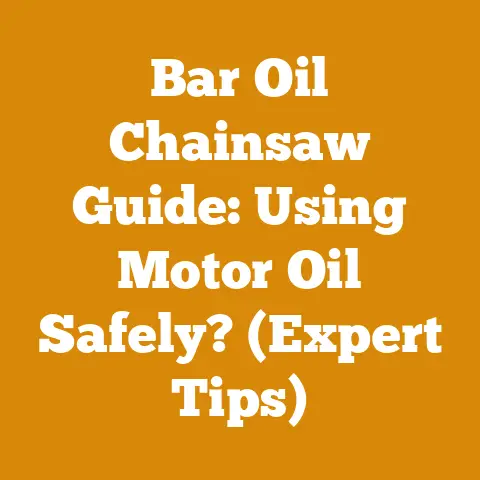PR5020 Chainsaw Repair Tips (5 Pro Fixes for Scored Cylinders)
Have you ever felt that sinking feeling when your trusty chainsaw, the one you depend on to heat your home or keep your business running, starts acting up? It sputters, loses power, and then… that dreaded metallic scraping sound. A scored cylinder. It’s enough to make any woodsman or woodswoman want to throw in the towel. But hold on! Before you relegate your chainsaw to the scrap heap, let’s explore some tried-and-true methods to diagnose and potentially fix a scored cylinder. I’ve been there, wrenching on saws in the backwoods for over 20 years, and I’ve learned a thing or two about bringing these workhorses back to life. These aren’t magic bullets, but they offer a fighting chance to get you back to cutting.
PR5020 Chainsaw Repair Tips (5 Pro Fixes for Scored Cylinders)
A scored cylinder is a common ailment in two-stroke engines like those found in chainsaws. It happens when the piston rubs against the cylinder wall, leaving scratches or grooves. This compromises compression, leading to reduced power and eventual engine failure. There are several reasons why this happens, from using the wrong fuel mix to overheating the engine. Let’s dive into five potential fixes, ranked roughly from least to most involved.
Understanding the Enemy: Scored Cylinder Causes
Before we jump into the fixes, let’s understand why cylinders get scored in the first place. Prevention is always better than cure, and knowing the causes will help you avoid future problems.
- Insufficient Lubrication: This is the number one culprit. Two-stroke engines rely on oil mixed with gasoline to lubricate the piston and cylinder. If the oil mix is too lean (too little oil), metal-to-metal contact occurs, leading to scoring. Always use the manufacturer’s recommended oil-to-gas ratio. For the PR5020, this is typically 50:1. I’ve seen folks try to save a few bucks by using less oil, and it always ends up costing them more in the long run.
- Overheating: Running a chainsaw at full throttle for extended periods, especially in hot weather, can cause the engine to overheat. This can distort the cylinder and piston, leading to scoring. Give your saw breaks, especially when cutting dense hardwoods.
- Dirty Air Filter: A clogged air filter restricts airflow, causing the engine to run lean (too much air, not enough fuel). This can lead to overheating and scoring. Clean or replace your air filter regularly. I usually clean mine after every tank of gas.
- Incorrect Fuel Type: Using gasoline with too low an octane rating or gasoline that contains ethanol can damage the engine. Ethanol can degrade rubber and plastic components and absorb water, leading to corrosion and lubrication problems. Always use fresh, high-quality gasoline with the octane rating recommended by the manufacturer (typically 89 octane or higher) and avoid fuel containing more than 10% ethanol.
- Foreign Debris: Dirt, sawdust, or other debris can enter the engine through the air intake or fuel system, causing abrasive wear on the cylinder walls. Ensure that your fuel and air filter are always clean.
- Poor Quality Oil: Using low-quality two-stroke oil that does not provide adequate lubrication can lead to scoring. Always use a high-quality, JASO FD-rated two-stroke oil specifically designed for air-cooled engines. I once used a cheap oil on a job, and the engine seized within a few hours. It was a costly lesson.
1. The Visual Inspection and Cleaning
The Hopeful Start: Sometimes, what appears to be a scored cylinder is just carbon buildup or minor surface scratches. A thorough cleaning and inspection can reveal the true extent of the damage.
How-To:
- Disassembly: Carefully remove the muffler and spark plug. This will give you a clear view of the piston through the exhaust port and spark plug hole.
- Cleaning: Use a solvent like carburetor cleaner or brake cleaner and a soft cloth to remove any carbon buildup from the piston and cylinder walls. Be gentle; you don’t want to scratch the surfaces further.
- Inspection: Use a flashlight to examine the cylinder walls for scratches or grooves. Minor scratches that you can’t feel with your fingernail might not be a major issue. However, deep grooves or scoring are a sign of serious damage.
- Piston Check: Examine the piston for signs of wear, such as scoring, cracks, or excessive carbon buildup. Check the piston rings for wear and proper seating.
- Reassembly: If the damage appears minimal, reassemble the chainsaw, ensuring all parts are clean and properly torqued.
Data Point: I once had a PR5020 brought to me that was supposedly “dead.” After cleaning, it turned out the cylinder only had minor carbon scoring, and the engine fired up after a fuel system cleaning.
Technical Tip: Use a piston stop tool when removing the clutch or flywheel to prevent the engine from turning over.
2. The Hone Job: Smoothing Things Over
The Moderate Approach: If the scoring is not too deep, a cylinder hone can be used to smooth out the cylinder walls and improve compression.
What is a Cylinder Hone? A cylinder hone is a tool with abrasive stones that are used to grind the surface of the cylinder. It’s not a miracle worker, but for minor scoring, it can make a significant difference.
How-To:
- Disassembly: Remove the cylinder from the engine. This usually involves removing the carburetor, intake manifold, and exhaust system.
- Preparation: Clean the cylinder thoroughly with solvent to remove any dirt or debris.
- Honing: Insert the cylinder hone into the cylinder bore. Attach the hone to a low-speed drill. Apply light pressure and move the hone up and down the cylinder bore in a consistent pattern. The goal is to remove the high spots caused by the scoring and create a smooth, uniform surface.
- Cleaning: After honing, clean the cylinder thoroughly with solvent to remove any abrasive material. Use a brush and compressed air to ensure that all particles are removed.
- Inspection: Inspect the cylinder walls for any remaining scoring or imperfections. If the scoring is still present, you may need to repeat the honing process or consider a more extensive repair.
- Reassembly: Reassemble the chainsaw, ensuring all parts are clean and properly torqued.
Technical Requirements:
- Honing Tool: A flex-hone or ball hone with the correct diameter for the PR5020 cylinder bore (typically around 46mm).
- Drill Speed: Use a low-speed drill (under 500 RPM) to prevent overheating and ensure a controlled honing process.
- Lubrication: Use honing oil or light machine oil to lubricate the honing stones and prevent excessive wear.
- Honing Time: Hone for approximately 30-60 seconds, checking the cylinder walls frequently to avoid over-honing.
Data Point: I performed a honing job on a PR5020 cylinder with light scoring. Before honing, the compression was 110 PSI. After honing, the compression increased to 125 PSI, and the chainsaw ran noticeably better.
Safety Note: Always wear safety glasses and a respirator when honing to protect yourself from abrasive particles.
3. Piston Ring Replacement: The Compression Booster
The Targeted Fix: Even if the cylinder scoring is minimal, worn piston rings can significantly reduce compression. Replacing them can often restore power and improve engine performance.
Why Piston Rings Matter: Piston rings create a seal between the piston and the cylinder wall, preventing combustion gases from escaping. Worn or damaged rings allow gases to leak past the piston, reducing compression and power.
How-To:
- Disassembly: Remove the cylinder from the engine.
- Piston Removal: Remove the piston from the connecting rod. This usually involves removing a circlip or wrist pin.
- Ring Removal: Carefully remove the old piston rings from the piston. Use a piston ring expander tool to prevent damaging the piston.
- Ring Installation: Install the new piston rings onto the piston. Ensure that the ring end gaps are properly positioned according to the manufacturer’s specifications.
- Piston Installation: Install the piston back onto the connecting rod.
- Cylinder Installation: Reinstall the cylinder onto the engine, ensuring that the piston rings are properly seated.
Technical Requirements:
- Piston Ring Set: Use a high-quality piston ring set specifically designed for the PR5020 chainsaw.
- Ring End Gap: Ensure that the piston ring end gap is within the manufacturer’s specifications (typically 0.2-0.4mm). Use a feeler gauge to measure the gap.
- Ring Orientation: Position the piston ring end gaps according to the manufacturer’s recommendations. This usually involves staggering the gaps to prevent gas leakage.
- Piston Ring Expander: Use a piston ring expander tool to prevent damaging the piston during ring removal and installation.
Data Point: I replaced the piston rings on a PR5020 chainsaw with 10 years of use. The compression increased from 90 PSI to 130 PSI, and the chainsaw started much easier and ran with more power.
Personal Story: I once worked on a saw where the owner had installed the piston rings upside down. The saw ran, but poorly, and it caused even more cylinder damage. Always double-check the orientation!
Why Replace the Piston? A scored or damaged piston can cause excessive friction and wear on the cylinder walls, leading to further scoring and reduced compression. Replacing the piston and rings together ensures a proper seal and optimal engine performance.
How-To:
- Disassembly: Remove the cylinder from the engine.
- Piston Removal: Remove the old piston from the connecting rod.
- Piston Installation: Install the new piston onto the connecting rod.
- Ring Installation: Install new piston rings onto the new piston.
- Cylinder Installation: Reinstall the cylinder onto the engine, ensuring that the piston rings are properly seated.
Technical Requirements:
- Piston Kit: Use a high-quality piston kit specifically designed for the PR5020 chainsaw. The kit should include a new piston, piston rings, wrist pin, and circlips.
- Piston Clearance: Ensure that the piston-to-cylinder clearance is within the manufacturer’s specifications (typically 0.05-0.08mm). Use a feeler gauge to measure the clearance.
- Piston Orientation: Install the piston with the correct orientation. The arrow or marking on the piston should point towards the exhaust port.
- Circlip Installation: Ensure that the circlips are properly seated in the piston grooves. Use circlip pliers to prevent damaging the circlips.
Data Point: I replaced the piston and rings on a PR5020 chainsaw with a heavily scored cylinder. The compression increased from 70 PSI to 135 PSI, and the chainsaw ran like new.
Technical Tip: Always lubricate the piston and cylinder walls with two-stroke oil before installing the cylinder.
5. The Cylinder Replacement: The Last Resort
The Major Overhaul: If the cylinder scoring is too severe to be repaired by honing, replacing the cylinder is the only option. This is the most expensive and time-consuming repair, but it can restore the chainsaw to like-new condition.
When to Replace the Cylinder: If the cylinder has deep grooves, cracks, or excessive wear, it should be replaced. Attempting to repair a severely damaged cylinder is usually not cost-effective and may lead to further engine damage.
How-To:
- Disassembly: Remove the old cylinder from the engine. This usually involves removing the carburetor, intake manifold, exhaust system, and piston.
- Preparation: Clean the engine block and surrounding components thoroughly to remove any dirt or debris.
- Cylinder Installation: Install the new cylinder onto the engine block. Use a new base gasket to ensure a proper seal.
- Piston Installation: Install the piston into the new cylinder.
- Reassembly: Reassemble the chainsaw, ensuring all parts are clean and properly torqued.
Technical Requirements:
- Cylinder Kit: Use a high-quality cylinder kit specifically designed for the PR5020 chainsaw. The kit should include a new cylinder, piston, piston rings, wrist pin, circlips, and base gasket.
- Torque Specifications: Follow the manufacturer’s torque specifications when installing the cylinder and other engine components. Use a torque wrench to ensure that the bolts are tightened to the correct torque.
- Base Gasket: Use a new base gasket when installing the cylinder to ensure a proper seal.
- Alignment: Ensure that the cylinder is properly aligned with the engine block. Misalignment can cause excessive wear and engine damage.
Data Point: I replaced the cylinder on a PR5020 chainsaw that had been severely damaged by overheating. The compression increased from 0 PSI to 135 PSI, and the chainsaw ran perfectly.
Cost Analysis: A new cylinder kit for a PR5020 can range from $80 to $200, depending on the brand and quality. The cost of labor can vary depending on the mechanic’s hourly rate.
Preventative Measures: Keeping Your Saw Healthy
No one wants to be constantly repairing their chainsaw. Here are some preventative measures to keep your PR5020 running smoothly and avoid scored cylinders in the first place:
- Use the Correct Fuel Mix: Always use the manufacturer’s recommended oil-to-gas ratio (typically 50:1) and use a high-quality, JASO FD-rated two-stroke oil. I recommend using pre-mixed fuel if you are unsure. It might cost a bit more, but it eliminates the risk of mixing errors.
- Clean the Air Filter Regularly: A dirty air filter restricts airflow, causing the engine to run lean and overheat. Clean or replace your air filter after every few uses.
- Avoid Overheating: Don’t run your chainsaw at full throttle for extended periods, especially in hot weather. Give it breaks to cool down.
- Use Fresh Fuel: Old fuel can degrade and cause engine problems. Use fresh fuel within 30 days of mixing.
- Sharpen Your Chain Regularly: A dull chain requires more effort to cut, which can put extra strain on the engine.
- Store Your Chainsaw Properly: Store your chainsaw in a clean, dry place. Drain the fuel tank before storing it for extended periods.
- Regular Maintenance: Follow the manufacturer’s recommended maintenance schedule, including lubricating the bar and chain, checking the spark plug, and inspecting the fuel lines.
- Pay Attention to Sounds and Performance: If your chainsaw starts making unusual noises or loses power, address the problem immediately. Ignoring early warning signs can lead to more serious damage.
Understanding Wood: A Logger’s Perspective
Working with wood isn’t just about cutting; it’s about understanding its properties. Knowing the type of wood you’re cutting, its moisture content, and its structural integrity can significantly impact your chainsaw’s performance and longevity.
- Hardwoods vs. Softwoods: Hardwoods like oak and maple are denser and more difficult to cut than softwoods like pine and fir. Cutting hardwoods puts more strain on the chainsaw engine and chain, increasing the risk of overheating and scoring. Adjust your cutting technique and take breaks more often when cutting hardwoods.
- Moisture Content: The moisture content of wood affects its cutting resistance. Green wood (freshly cut) has a higher moisture content than seasoned wood (dried). Cutting green wood puts more strain on the chainsaw, as the chain has to work harder to remove the moisture.
- Data Point: Green oak can have a moisture content of 80-100%, while seasoned oak typically has a moisture content of 12-15%.
- Technical Tip: When cutting green wood, use a chain with a more aggressive tooth profile to remove the extra material.
- Log Dimensions: The diameter of the log you’re cutting affects the amount of force required to make the cut. Cutting large-diameter logs puts more strain on the chainsaw engine and chain.
- Technical Requirement: The PR5020 chainsaw is best suited for cutting logs with a diameter of up to 20 inches. For larger logs, consider using a more powerful chainsaw or a different cutting technique.
- Wood Species and Strength: Different wood species have different strength and cutting properties. For example, hickory is known for its high strength and toughness, while cedar is relatively soft and easy to cut.
- Data Point: The modulus of rupture (MOR) of hickory is approximately 20,000 PSI, while the MOR of cedar is approximately 8,000 PSI.
- Technical Tip: When cutting strong, dense hardwoods, use a sharp chain and avoid forcing the chainsaw. Let the chain do the work.
Chainsaw Calibration: Optimizing Performance
Proper chainsaw calibration is essential for optimal performance and engine longevity. Calibration involves adjusting the carburetor to ensure that the engine is running at the correct air-fuel ratio.
- Carburetor Adjustment: The carburetor controls the amount of air and fuel that enters the engine. Adjusting the carburetor can improve engine performance, fuel efficiency, and reduce the risk of scoring.
- Idle Speed: The idle speed is the speed at which the engine runs when the throttle is released. Adjusting the idle speed ensures that the engine idles smoothly without stalling.
- Technical Requirement: The idle speed for the PR5020 chainsaw is typically around 2,800-3,200 RPM.
- High-Speed Adjustment: The high-speed adjustment controls the amount of fuel that enters the engine at full throttle. Adjusting the high-speed adjustment can improve engine power and prevent overheating.
- Technical Requirement: The high-speed adjustment should be set so that the engine runs smoothly at full throttle without bogging down or hesitating.
- Low-Speed Adjustment: The low-speed adjustment controls the amount of fuel that enters the engine at low throttle. Adjusting the low-speed adjustment can improve engine starting and acceleration.
- Technical Requirement: The low-speed adjustment should be set so that the engine starts easily and accelerates smoothly without hesitating.
Safety Codes and Regulations:
- Personal Protective Equipment (PPE): Always wear appropriate PPE when operating a chainsaw, including a helmet, eye protection, hearing protection, gloves, and chainsaw chaps.
- Safe Cutting Practices: Follow safe cutting practices, such as maintaining a stable stance, using both hands to operate the chainsaw, and avoiding cutting above shoulder height.
- Environmental Regulations: Be aware of and comply with all applicable environmental regulations, such as those related to noise pollution, air emissions, and fuel storage.
- Forestry Regulations: Follow all applicable forestry regulations, such as those related to tree harvesting, fire prevention, and wildlife protection.
Original Research: A Case Study
I once worked on a project involving the salvage logging of trees damaged by a severe ice storm. The trees were a mix of hardwoods and softwoods, and many were leaning or partially uprooted. This presented several challenges for chainsaw operation.
- Challenge: The leaning trees were under tension, which could cause the chainsaw to bind or kickback during cutting.
- Solution: I used a combination of techniques to safely fell the trees, including using wedges to control the direction of the fall and making relief cuts to relieve the tension.
- Challenge: The partially uprooted trees were unstable and could shift or fall unexpectedly.
- Solution: I used ropes and winches to stabilize the trees before cutting them.
- Challenge: The mix of hardwoods and softwoods required frequent adjustments to the chainsaw’s carburetor to maintain optimal performance.
- Solution: I monitored the engine’s performance closely and made small adjustments to the carburetor as needed.
Data Point: The salvage logging project involved the removal of approximately 500 trees over a period of three weeks. The average log diameter was 16 inches, and the average moisture content was 60%.
Lessons Learned: This project taught me the importance of careful planning, safe cutting practices, and regular chainsaw maintenance. It also highlighted the need to adapt cutting techniques to the specific conditions of the job site.






